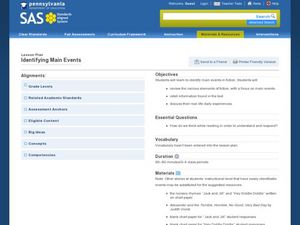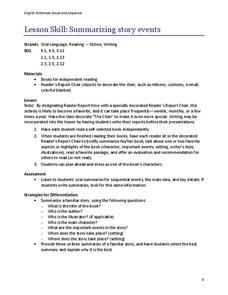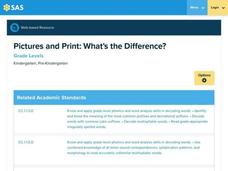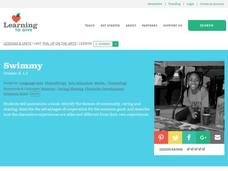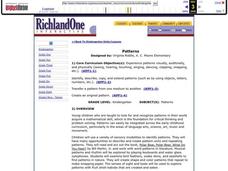Curated OER
Identifying Main Events
Help kindergartners learn to identify the main events in fiction. They will review elements of fiction, retell information found in the text, and discuss their real-life daily experiences. All the while, they will be asking themselves...
Curated OER
Chrysanthemum
Our uniqueness should be celebrated, not teased. The story Chrysanthemum addresses having a distinct name and dealing with different perceptions. Pre- and post-reading questions are listed to help your learners understand...
Curated OER
Inferring Character Traits
Here is a lesson which is "flexible," and can operate as an individual or whole class activity. After reading a book of their choosing, with the use of a semantic map, learners identify character traits. They infer how their feelings...
Scholastic
Quick as a Cricket Lesson Plan
Teaching young learners about similes is easy as pie with this primary grade language arts lesson. Following a class reading of the children's book, Quick as a Cricket by Audrey Wood, young readers learn the definition of a simile...
Curated OER
Dusty Locks and the Three Bears
Read this twist on Goldilocks and the Three Bears: Dusty Locks and the Three Bears by Susan Lowell. Kindergartners listen, predict, and discuss the story. They then participate in a dramatization of the story and draw a picture...
Curated OER
Goodnight Goon
Students identify fictional story elements. In this reading comprehension activity, students read the book Goodnight Goon, which is a parody of Goodnight Moon, and discuss the story elements. Students use an included worksheet to record...
Curated OER
Dan, the Flying Man Comes to Our Town
Students listen to a read aloud of "Dan, the Flying Man" and complete a class re-write of the book highlighting what the main character would fly over if he flew over their town. They may keyboard their entry into the class book.
Curated OER
Special Sunflowers
Students view a picture of Van Gogh's Sunflowers. In this caring and kindness lesson students read Camille and the Sunflower and explore the feelings of the characters. Students complete worksheets related to Camille's feelings in the book.
Curated OER
The Hundred Dresses by Eleanor Estes
Young scholars listen to story The Hundred Dresses, and use adjectives to describe each character.
Curated OER
Responsibility and Jobs
Students identify community helpers. For this philanthropy lesson, students read Strega Nona and identify different characters' responsibilities in the story. Students use character traits to describe the main characters and make a list...
Curated OER
Summarizing Story Events
Here is a way to build your pupils' public speaking abilities. The lesson describes a reader's report chair, which is used each week by a student who has just finished reading a book. The featured reader sits in the chair and talks about...
Curated OER
Character Scrapbook Teacher's Guide
Students analyze a book's characters and create a scrapbook to print and save. In this on line interactive characterization lesson plan, students identify character traits and gain a deeper understanding of a book's characters.
Curated OER
The Bones of a Story
For this Language Arts worksheet, students read a Clifford book and describe 5 story elements. These include title, setting, characters, problem, events, and resolution.
Curated OER
Making a Choice
Students read and discuss the text Miss Rumphius. In this philanthropy lesson, students discuss how the characters in the book made the world beautiful and create a class book of good deeds.
Curated OER
There's a Monster in My Closet!
Students create their own monsters that exist in their imaginary closets and decorate their environment. They then write a short story to describe their illustration using a prompt.
Pennsylvania Department of Education
Pictures and Print: What's the Difference?
Students watch a PowerPoint presentation. In this early literacy lesson, students watch a PowerPoint presentation describing print from pictures and the difference between the two.
Curated OER
Tales From Around the World
Students read stories. In this culture lesson plan, students read stories from different regions around the world. Students look for each region on the map and listen for interesting cultural details in the story. Students then discuss...
Curated OER
Yes, You Can!
Students examine the concept of encouragement. In this encouragement and character lesson, students participate in an active read aloud of Mary Grace's, Amazing Grace. They draw a picture in their journal of a time that they needed...
Curated OER
Narrative pantomime
Assign parts to read aloud Millions of Cats by Wanda Gag and have your young mimes act out their roles. This story focus on how beauty within is more important than outward appearance. Conclude by having your class provide an illustrated...
Museum of Disability
Stand Tall, Molly Lou Melon
Help to create the next generation of friends with a lesson about accepting people who are different. As kids read Stand Tall, Molly Lou Melon, they answer a series of discussion questions and activities about making friends...
Museum of Disability
Zoom!
Turn your class' focus on how wheelchairs assist individuals with disabilities to become more independent with this disabilities lesson plan. Scholars listen to a read aloud of the book, Zoom! by Robert Munsch, answer...
Curated OER
Using Words to Work Things Out
Students recognize a problem and how to resolve it. In this lesson, students listen to The Hating Book and discuss the events of the story. Students answer comprehension questions and relate to their own experiences. Students role play...
Curated OER
Swimmy
Students explore the themes of the book Swimmy by Leo Lionni. In this literacy lesson, students dramatize a character from Swimmy and identify common themes such as cooperation and caring. Students create a new ending to the story.
Curated OER
Patterns
Students create and extend patterns. In this pattern lesson, students learn to identify patterns using multiple senses. Students work at centers in small groups to explore and extend their understanding of patterns.
